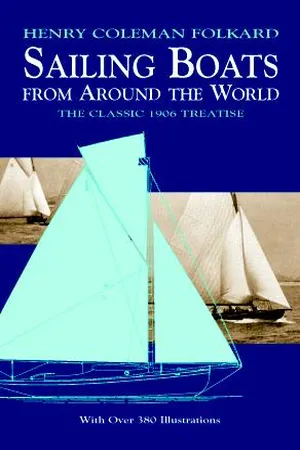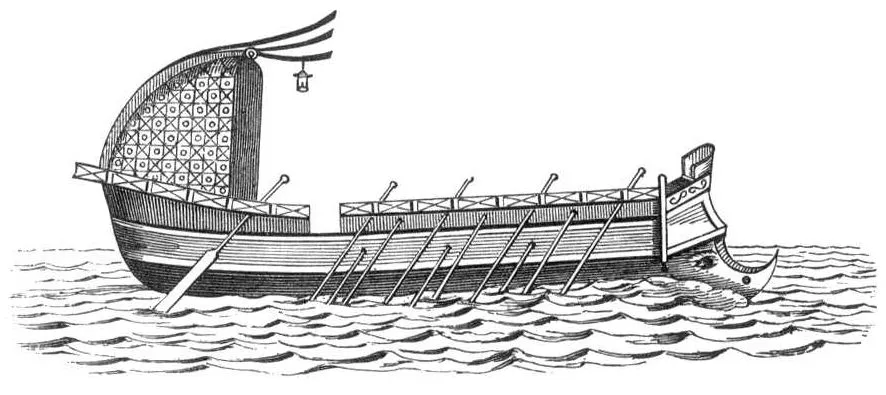
- 576 pages
- English
- ePUB (mobile friendly)
- Available on iOS & Android
eBook - ePub
About this book
Comprehensive, profusely illustrated book documents early-20th-century sailing. Includes detailed, instructional manual for beginning and experienced sailors, review of small vessels then in use; racing boats, odd and experimental vessels, and more. Over 380 line drawings and photographs, including body, deck, and sail plans. Nautical vocabulary. Indexes. Bibliography.
Frequently asked questions
Yes, you can cancel anytime from the Subscription tab in your account settings on the Perlego website. Your subscription will stay active until the end of your current billing period. Learn how to cancel your subscription.
No, books cannot be downloaded as external files, such as PDFs, for use outside of Perlego. However, you can download books within the Perlego app for offline reading on mobile or tablet. Learn more here.
Perlego offers two plans: Essential and Complete
- Essential is ideal for learners and professionals who enjoy exploring a wide range of subjects. Access the Essential Library with 800,000+ trusted titles and best-sellers across business, personal growth, and the humanities. Includes unlimited reading time and Standard Read Aloud voice.
- Complete: Perfect for advanced learners and researchers needing full, unrestricted access. Unlock 1.4M+ books across hundreds of subjects, including academic and specialized titles. The Complete Plan also includes advanced features like Premium Read Aloud and Research Assistant.
We are an online textbook subscription service, where you can get access to an entire online library for less than the price of a single book per month. With over 1 million books across 1000+ topics, we’ve got you covered! Learn more here.
Look out for the read-aloud symbol on your next book to see if you can listen to it. The read-aloud tool reads text aloud for you, highlighting the text as it is being read. You can pause it, speed it up and slow it down. Learn more here.
Yes! You can use the Perlego app on both iOS or Android devices to read anytime, anywhere — even offline. Perfect for commutes or when you’re on the go.
Please note we cannot support devices running on iOS 13 and Android 7 or earlier. Learn more about using the app.
Please note we cannot support devices running on iOS 13 and Android 7 or earlier. Learn more about using the app.
Yes, you can access Sailing Boats from Around the World by Henry Coleman Folkard in PDF and/or ePUB format, as well as other popular books in Technology & Engineering & Marine Transportation. We have over one million books available in our catalogue for you to explore.
Information
PART I.
BOATS OF THE ANCIENTS.
‘Illi robur et æs triplex
Circa pectus erat, qui fragilem truci
Commisit pelago ratem
Primus.’—HOR. Od. I. iii. 9.
Circa pectus erat, qui fragilem truci
Commisit pelago ratem
Primus.’—HOR. Od. I. iii. 9.
THE boats or vessels of the Ancients were of a very diminutive size in comparison with those of later date. Few of them exceeded the ordinary dimensions of a modern ship’s launch. But as civilization advanced boats and vessels of larger size were constructed, though in a rude and primitive style; and when provided with vessels of burthen, it was a long time before the boldest mariners ventured to trust themselves and their vessels far from land.
The earliest mode of navigation was by rafts constructed of balks or planks of wood, to which were afterwards added borders of wicker-work, covered with the skins of animals. Of this kind were the Coracle of Ancient Britain, and the Cymba sutilis of Virgil.
It is mentioned by Homer that the boat built by Ulysses was put together with wooden pegs instead of bolts; 1 and that the gunwale was raised by hurdles of osiers to keep off the waves of the sea.2
The Egyptians had boats of terra cotta, and some of the leaves of the papyrus ; the Indians made rafts and boats of bamboo cane. The skins of animals were used by the Romans and others for the outer covering of boats; and the Roman boatmen were called Utricularii.
The invention of ships was not known to the Romans until after the first Punic war, A.U.C. 490.3
To be represented in a boat was the Egyptian symbol of apotheosis ; and many Emperors (as our Kings in a ship on their coins) are thus distinguished.4
The early Greeks are mentioned in history as the first who devoted attention to boat-building; the Trireme, Bireme, and other galleys were of their invention. The Trireme, which had three ranks or benches of rowers, was preceded by the Bireme with two such ranks; and the latter was a modification of the simple galley or long-ship, with only one rank on each side.5 The bows of some of the war-galleys were ornamented with carved heads of boars and other ferocious animals, projecting four or five feet; beneath which was a sharp iron pike or rostrum. It was in boats of this kind that the first naval action recorded in history was fought between the Greeks and their colonists, the inhabitants of Corfu.

A Trireme, after Bafius, Schæffer, and others.
The Romans afterwards improved upon the trireme, and built a faster class of vessels, called the Liburni : these were more manageable than the others, and better adapted for sailing. The Liburnian galleys were in use at the beginning of the Roman Empire ; and the naval engagement at Actium, in which Augustus Cæsar was victorious over Antony, was fought and won in Liburnian galleys.
An Etruscan boat has the prow turned up, but the stern flat and concave, with a hole in the side for the rudder. The latter is merely a long oar for steering.6
In most of the vessels of the ancients it appears that the prow was made in the form of a fish, a dolphin, or the head of some animal, with the eyes very distinctly marked on both sides.
Vessels with oars long preceded those with sails. But whatever kind of sail was used, it was never relied on as the only means of propulsion : all ancient vessels were provided with oars, but the use of thowls in which to work them was apparently unknown, as the bulwarks or sides of the vessel were pierced with round holes, through which the oars were thrust and worked ; and in vessels of the larger size, such as the Liburni, in which the rowers sat in tiers one above the other, the oars were worked in the same manner: the boat being termed a bireme if there were two tiers of rowers, and trireme if three. Homer mentions masts, but not fixed, only put up as wanted.
As to rudders, some vessels had two, others four, two at the prow and two at the stern.
The ancient practice of rowing was as follows:—a boatman-director, called Celeustes, gave the signal for the rowers to pull, and encouraged them by his song. This song, termed the celeusma, was either sung by the rowers, played upon instruments, or effected by striking a gong, after the manner of the Chinese, Japanese, and others at the present day. Ossian and others mention the rowing song :—
‘And all the way to guide their chime,
With falling oars they kept the time.’
With falling oars they kept the time.’
The commander of the rowers, called Hortator remigum, Pausarius, and Portisculus, was placed among them in the middle of the boat. He carried a staff, with which he signalled by waving or otherwise when his voice could not be heard. The Anglo-Saxon batswan (boatswain) also used a staff wherewith to direct the rowers.
The Greeks had boats called ampheres; these were long and narrow, and were rowed by a single boatman only, with one pair of sculls. Rowing with the face to the prow is mentioned as customary with the ancients ; but this may have been paddling, or pushing ahead with a paddle or sweep.
The oar upon the Etruscan vases is in the form of a narrow pyramid from top to bottom.
Baldarius was the inventor of oars, as applied to large fighting vessels. 7
Masts and sails are said to have been invented by Dædalus. Varro says they were invented by Isis, who, with an affection bolder than usually falls to the lot of women, sailed in quest of her son Harpocrates : so that while her maternal fondness urged her to the completion of her wishes, she appears to have displayed to the world arts till then unknown to it.8
In Stosch and the Florentine Museum is a small vessel with oars, the prow of which ends in a cheniscus of the form of a swan’s neck. Precisely in the place of a mast and mizzen sail are two large extended wings, proper to catch the wind, as if for flying. This would seem to explain the fable of Dædalus.
The cheniscus, or swan’s neck, was also, it appears, an ornament of the stern, but bent downwards towards the sea.9
The hull of the ancient galleys, as improved by the classical ancients, was made in conformation of the body of a duck, which was said to furnish the best model.10
The materials of which sails were anciently made were rushes, broom stuff, skins of animals, and the dried skins of the intestines of animals and fish ; linen and hemp were afterwards used; indeed, from the time of Homer, linen was in use.
The forms of ancient sails were various—square, circular, crescent-shaped, and triangular, and the colours white, blue, purple, and sometimes curiously painted. According to Pliny, they were at first set one above another on the same mast ; and afterwards on two masts, at the stern and prow.

Navigiolum ad animum oblectandum.
The sails set on the stern or mizzen-mast were called epidromus ; those on the foremast at the prow dolones ; at the top of the mast thoracium ; stun sails, called orthiax, were also used occasionally in very light winds. Sometimes, when two or more masts were used, the sail of the main-mast was called artemon.
The topsails were of a triangular or latine shape, and were sometimes set with the apex downwards.11
It is clear that both sails and oars were employed in many of the vessels of the ancients. Winckelman, however, observes that ships disposed for battle had neither sails nor yards.12
The boats and vessels of the classical ancients were of many kinds; with ten, twenty, thirty, and up to 100 oars. Those distinct from war service were as under :—13
Actuariœ naves—Long and light vessels, propelled both by oars and sails : never manned by less than twenty rowers.
Annotinœ Frumentariœ—Provision vessels.
Busse—A ship made like a wine-cask.
Calones—Boats for carrying wood.
Cercuri—Ships of burthen, both with sails and oars.
Celoces, or the Greek Celetes—Light vessels, used chiefly for piracy, with only two sets of oars, without deck or rostra.
Catascopia—Small despatch vessels, for carrying letters and reconnoitring.
Constratœ—Those which were entirely decked.
Cubiculatœ—Those with cabins and the conveniences of a house.
Dromones—Long boats, first used in rowing matches.
Fluviatiles—Boats of the river, as distinguished from those of the sea.
Gauli—Phœni...
Table of contents
- Title Page
- Copyright Page
- PREFACE - TO THE SIXTH EDITION.
- Table of Contents
- Table of Figures
- PART I. - BOATS OF THE ANCIENTS.
- PART II. - SAILING BOATS OF THE BRITISH ISLANDS.
- PART III. - PRACTICAL.
- PART IV. - SMALL RACING YACHTS AND YARAFTS.
- PART V. - THE ONE-DESIGN AND RESTRICTED CLASSES.
- PART VI. - FISHING AND SHOOTING BOATS.
- PART VII. - SAILING CHARIOTS AND ICE YACHTS.
- PART VIII. - FOREIGN AND COLONIAL BOATS.
- PART IX. - NAUTICAL VOCABULARY.
- INDEX.